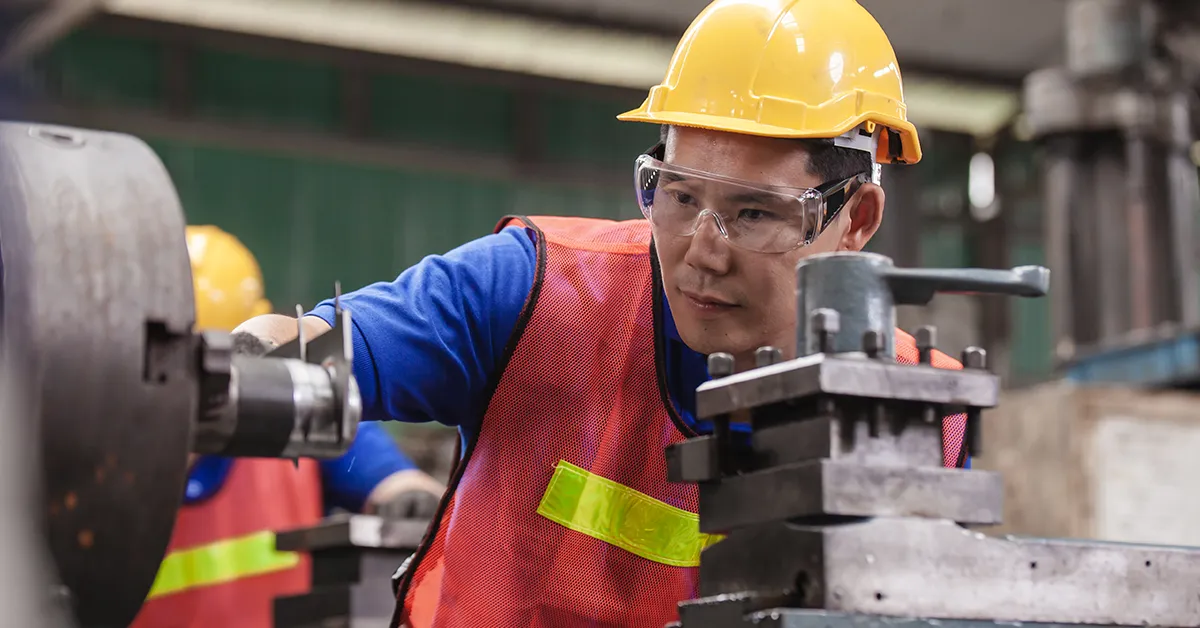
Key takeaways
- No single maintenance strategy fits every asset. The best approach is a combination of strategies, such as run-to-failure for low-criticality items and predictive maintenance for high-value, critical equipment.
- Asset characteristics determine strategy choice. Age, manufacturer, maintenance history, criticality, and replacement costs all influence whether preventive, predetermined, condition-based, or predictive methods are most effective.
- Technology enables smarter maintenance. Sensors, data analysis, and predictive algorithms allow facility managers to detect issues earlier, optimize maintenance schedules, and reduce unplanned downtime.
Saying you need better maintenance isn’t enough. If you want a program packed with processes that work for you, you need to choose the right maintenance strategy, which starts with knowing your options, what they can deliver, and how best to implement them.
Why are there different types of maintenance strategies?
Why isn’t there one perfect strategy for maintenance? After all this time, why haven’t facility and maintenance managers fine-tuned their programs to perfection?
One of the answers is that because there are different types of assets, there are different strategies. Different machines break down for different reasons and in different ways, so you need tailored ways to keep them up and running.
It seems a bit obvious to say not all assets and equipment are the same. But it’s worth remembering that there are even different kinds of differences. Any two assets can be different in terms of how they work and how they usually break. So, an AC unit is not the same as an ice machine. But even two similar assets, for example, two AC units, can be different in terms of:
- Age
- Manufacturer
- Repairs and maintenance histories
- Relative criticality
And because of these differences, you could have two similar units that each need a different maintenance strategy. The AC unit that cools one of the smaller employee breakrooms might only deserve a few annual inspections and tasks, while the ones cooling the server room where you’re running mission-critical software requires much more attention.
That’s one of the answers. Another is that new technologies make new strategies possible. When new tech gives us a new ability, we can leverage it into a new strategy. With condition-based maintenance and predictive maintenance, for example, sensors mounted on your assets and equipment capture a constant stream of data that you can use to help determine when to schedule the next maintenance inspections and tasks.
What are the maintenance strategies?
There are six main maintenance strategies:
- Reactive (run-to-failure)
- Preventive maintenance
- Predetermined maintenance
- Corrective maintenance
- Condition-based maintenance
- Predictive maintenance
Remember, that list is not in order from best to worst. Each is perfect for a specific set of circumstances. It’s the same as the relative differences between foods. Steaks are great, but the cost and care that goes into preparing them doesn’t make sense when you’re watching a baseball game or hosting a child’s birthday party.
Run-to-failure maintenance
Yes, this is a real strategy, even though it’s easy to confuse it with having no strategy at all. Here, you wait for things to break before you fix them.
The trick is choosing the right assets for the strategy. You need things that are cheap to carry in inventory, easy to replace, hard to inspect or maintain, and have a low criticality. Light bulbs are the classic example. Because they don’t require a special environment and aren’t too big, they’re relatively cheap to carry in inventory. When they burn out, screwing in a new one takes almost no time at all. Even if you wanted to swap them out just before they died, it would be time- and resource-consuming to accurately check how much longer any given filament can last.
And they are not generally critical to your operations. It’s hard to imagine a manufacturing facility having to shut down the line because of a burned-out light bulb.
Run-to-failure sometimes makes sense when you have duplicates of the same asset, making any given one of them redundant. You can wait for one to break down knowing that when you’re fixing it, you have all the others still running. The maintenance strategy can also make sense for continuous production facilities that use assets that rarely break down.
Instead of periodically shutting down the line for proactive maintenance, guaranteeing additional costs, you keep going until something breaks. Because breakdowns are so rare, your total cost of ownership is less.
Advantages of reactive maintenance
One of the overarching goals of maintenance is to get the most value out of your assets and equipment. You want maximum return on your investment, so you need to squeeze out every drop of value. With something like light bulbs, the only way to get all the possible value is to keep going until they burn out.
But it’s more than just getting the most value. You want to get the most value for the least amount of money. And run-to-failure can save you money because it usually requires a smaller maintenance team. Because you’re not running a schedule of planned maintenance, you only ever need a small number of techs. Another way you can save money is on training. While other strategies require special prep and training, even the most stuck-in-their-ways tech can understand reactive maintenance. “If it ain’t broke, don’t fix it” is a clear, simple concept.
Disadvantages of reactive maintenance
Although there’re many assets where reactive maintenance is the best choice, there are even more where you’re simply courting disaster. If you use the strategy on the wrong assets and equipment, you’re suddenly dealing with a lot of unscheduled downtime and expensive repairs.
Learn more about corrective maintenance.
Preventive maintenance
Here, you use a schedule of inspections and tasks (PMs) to find and fix small issues before they have a chance to develop into big problems. Preventive maintenance is basically the idea behind the old saying “An ounce of prevention is worth a pound of cure.”
How do you develop your schedules? It can depend on where you are in the asset’s life span and what sorts of problems you’re seeing. When an asset is new, it makes more sense to schedule everything according to the manufacturer’s recommendations. They’re the ones who designed and built it, so they know the asset best. But as time goes on, your senior techs likely have a better understanding of the asset’s common problems, and so you can adjust the schedule as needed.
You can base your scheduling on time or usage. For some PMs, you perform them according to calendar dates. So, for example, you have a tech look at the AC units in early spring, checking for any damage that happened over the winter. You might also have seasonal PMs for the roof. But for something like a hydraulic press, you can schedule PMs to trigger based on use. So, after X number of cycles, you have a list of inspections and maintenance tasks for the team.
Advantages of preventive maintenance
One way to understand the benefits of preventive maintenance is to look at all the hassles you avoid.
Because you know what work the maintenance team is going to do on any given day, you have more than enough lead time to ensure they have the right parts and materials. No more scrambling to find the right inventory. No more expensive rush deliveries. And it’s not just inventory.
Because you’ve scheduled the work in advance, you can easily schedule the right people to be there at the right times. No more calling in that one special tech for overtime because they’re the only one who’s good at troubleshooting that one tricky asset.
And because you can choose when things get done, you can easily schedule around peak production times. No more idle operators standing around watching the maintenance team. That’s a lot of stress you just avoided.
Disadvantages of preventive maintenance
It’s possible to stray over into over-maintenance, where you’re doing more than you need. Can you have too much of a good thing? In maintenance, you can.
The two big issues are extra waste and added risk. If you’re changing the fan belts on an engine too soon, you’re throwing out perfectly good inventory. And every time you open the hood and have a technician pull things apart and put them back together, you increase the risk of accidental damage. The tech might strip a bolt or drop a metal tool across the terminals on the battery. Even something as simple as checking the oil could introduce foreign objects into the engine.
Predetermined maintenance
When is it a good idea to have someone else set up your maintenance program? When they know your assets and equipment better than you do, which might be only right after you get them or could also be long into the asset and equipment life cycle.
Predetermined maintenance is when you simply follow the manufacturer’s recommendations for maintenance, including when to do inspections and maintenance.
Advantages of predetermined maintenance
All the work’s been done for you, so all you need to do is follow the schedule and do the work. And the schedule should be good because the manufacturer has based it on both their knowledge of their products and continuing research.
Disadvantages of predetermined maintenance
The program is based on averages, so it’s not always an exact match for your assets.
Stats can be both true and unhelpful. Imagine you’re sitting in a regular restaurant enjoying a nice meal. Bill Gates walks in, and suddenly, every single person in that restaurant is, on average, a multimillionaire. But do you feel any richer?
Condition-based maintenance
Just like the name suggests, condition-based maintenance is based on the asset or equipment’s condition. So, instead of setting up a schedule to periodically check on an asset, here you’re constantly monitoring it, looking for any deviations that suggest the start of trouble.
For example, you have an engine you want to maintain. You can set up a schedule where you check the temperature every three hours. Or you can just attach a sensor that constantly reads the temperature, setting off an alarm when things fall below or jump above set perimeters.
The idea is your sensor is set to always be on the lookout for a hint of smoke. As soon as it sees it, the sensor lets you know, and you can make sure those bits of smoke never have a chance to develop into a full-fledge fire.
Temperature is just one of the conditions you can monitor. Others include:
- Vibration
- Speed
- Power
- Moisture
And for all of them, you likely need a level somewhere in the middle, not too much or too little.
Advantages of condition-based maintenance
Condition-based maintenance is done while the assets are online, saving you on overall downtime. Now, instead of turning the equipment off to inspect it, you can keep it running and let the sensors do the work for you.
You also save on overall maintenance because you don’t have to schedule as many inspections, and you only perform tasks when you know you need them.
Being able to “see” inside an asset without having to shut it down and then lock it out saves you more than just time and effort. For many assets, it also saves you from the risk of damage to the asset and injury to technicians. Having a sensor on the fan over the welding stations means you have to send up a technician to check on it only when you already know there’s a problem.
Disadvantages of condition-based maintenance
Cost. Both for the required equipment as well as the additional training you need for your technicians, who now need to know how to set up and calibrate the sensors. In a way, you’ve created a new class of equipment for them to worry about maintaining.
That said, if you pick the right assets for the strategy, you can see concrete returns on your investment. But you have to choose the right assets and set up the sensors to look for the right things.
Even with the “right” sensors, though, you can still run into trouble if the environment is harsh enough to eventually break them. And even if they all survive, it’s generally hard for them to detect certain types of failures, including those caused by fatigue or uniform wear.
Learn more about condition-based maintenance.
Predictive maintenance
Basically, it’s the same as condition-based maintenance except that the data is analyzed to make accurate predictions about future failures.
For example: with condition-based, you have an engine that usually runs at temperature X. As soon as it goes above X plus Y, you know it needs maintenance. There’s a constant stream of data coming from the sensor, but the software only cares if it’s within the preset ranges.
But with predictive maintenance, the engine never has a chance to get to X plus Y because now that constant stream of data is being looked at closely by the software. In fact, it’s not simply looking, it’s analyzing it, pushing it through complex algorithms, hunting for clues. So, your engine might be well within the parameters for temperature, but the software still triggers maintenance after “decoding” the data and finding hints that something bad is going to happen.
Advantages of predictive maintenance
Ideally, you get all the benefits of condition-based maintenance, but you see them even faster.
Disadvantages of predictive maintenance
Cost. Now you have the same costs of condition-based maintenance plus the added expense of even more sophisticated software requiring even more specialized training for your staff.
And you have all the other drawbacks, too, including worrying about keeping your sensors properly calibrated and up and running.
How can you choose best maintenance strategy?
It’s a trick question. You don’t have to choose the one that’s best for you. Instead, choose the right strategy for each asset. For some, run-to-failure. For others, preventive. The question should be “What’s the right combination of maintenance strategies for my facility, assets, and equipment?”
Instead of thinking about strategies in isolation, you might be able to better understand them by seeing how they’re different from one another.
Reactive maintenance vs preventive maintenance
It’s not that one is better than the other. Instead, it’s that some assets match better with one than the other.
For reactive maintenance, an asset or piece of equipment needs to check some of these boxes:
- Impractical or impossible to maintain
- Cheap to buy and carry in inventory
- Easy to replace
- Low relative criticality
For assets that don’t fit any of these descriptions, it likely makes more sense to use preventive maintenance.
Preventive maintenance vs predetermined maintenance
Both strategies use a schedule of inspections and tasks to find and fix small issues before they become big, costly problems. The only real difference between the two is who’s writing out the schedule, you and your department or the manufacturer and their team of experts.
Just like with a lot of the other strategies, you don’t have to make a hard choice between strictly one or the other. When an asset is newer, you can use predetermined maintenance. Later, when you’ve built up a history of maintenance and repairs, you can start to fine-tune the schedule to better meet your specific situation.
Condition-based maintenance vs predictive maintenance
How do you know which one to use? Both have additional costs connected to equipment and training, but predictive is generally going to be the more expensive of the two. The way to choose between the two is to carefully consider the value of your asset, both its cost and how much it would cost you in time, money, and frustration if it unexpectedly failed.
Imagine you’ve decided to build yourself a garage but you’re not sure how much to invest. Your first step should be to look at your car, using its relative value to help you decide on the structure that’s going to protect it. Simple, reliable four-door sedan perfect for running to the grocery store? You need a simple, reliable garage. Fancy imported vintage sports car? It’s better to build something with all the possible garage bells and whistles, including a built-in lift and security system.
Summary
Choosing the right maintenance strategy starts with understanding your options, their benefits, and drawbacks. Run-to-failure tends to get a bad name, but for a specific class of assets and equipment, it’s the best choice. Use it when things are hard or impossible to maintain, cheap to carry in inventory, easy to replace, or non-essential to your operations.
Preventive maintenance helps you find problems early by scheduling inspections and tasks. It also saves you money and frustration because you can plan everything in advance. For predetermined maintenance, everything is basically the same as with preventive, except you’re following a schedule set up by the manufacturer, not your department. Condition based and predictive by relying on sensors and special software to collect and look at data from sensors installed directly on or near your assets.
For condition-based maintenance, the software is looking for readings outside preset parameters. For predictive, the software analyzes the data to predict future failures long before they start to develop. In the end, there is no one-size-fits-all, all-time perfect strategy.
You need to choose the combination that works best for your assets, fine-tuning your approach as your assets age and your department collects data.
Frequently asked questions
They include reactive (run-to-failure), preventive, predetermined, corrective, condition-based, and predictive maintenance—each suited to specific asset types and operational needs.
Both use sensors to monitor asset performance, but predictive maintenance adds advanced analytics to anticipate failures before they occur. The choice depends on the asset’s value, criticality, and your budget for technology and training.
Yes. In fact, most facilities benefit from a mixed approach—assigning different strategies to different assets based on their function, importance, and maintenance history.








